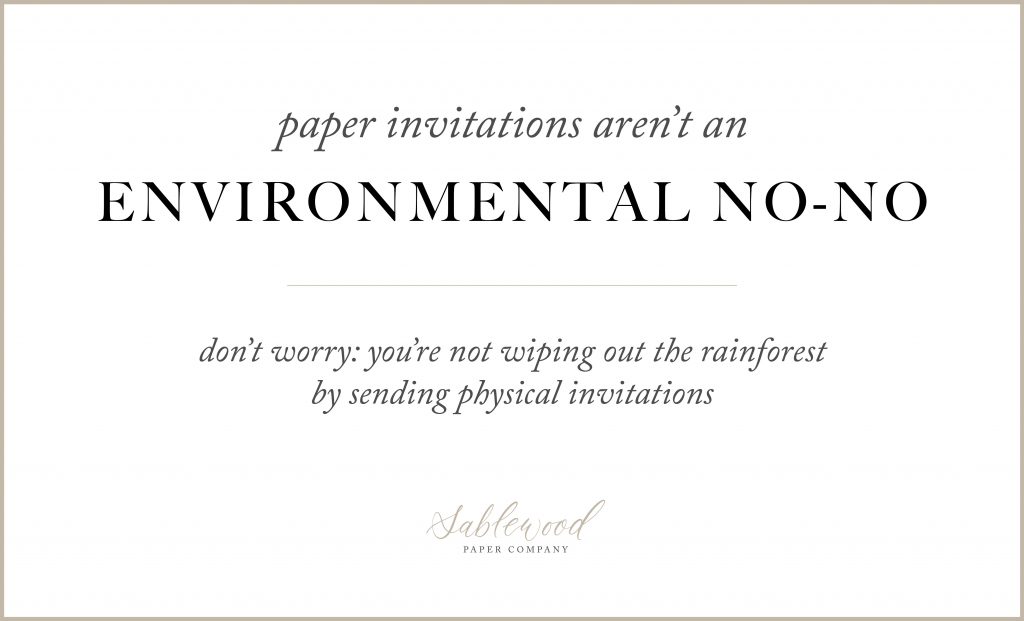Paper Invitations Aren’t an Environmental No-No
Don’t worry, you’re not wiping out the rainforest by sending physical invitations.
DISCLAIMER: This is a short introduction into VAST subject with a lot of information and perspectives (and opinions) that even I don’t know, because this isn’t my primary field of study and I’m not a paper manufacturer. I get all of my information from the FSC, the Sustainable Forest Initiative, and paper mills that I utilize in my business. My goal in writing this is to provide simplified education into why invitations don’t contribute to deforestation when sourced properly. This information pertains mostly to those in the US.
A couple of years ago, I met up with someone for the first time at a plant-based ice cream shop* in Seattle. If didn’t know that we’d become awesome friends within the first five minutes, I definitely did after we had one of the most interesting exchanges. I was not prepared for the questions this gal threw my way, but not because I didn’t know what to say.
Her question was (and I’m totally paraphrasing here): “Do you offer digital designs for clients who don’t want to send physical invites because it hurts the environment?”
I hear and read this with some frequency. It might be because I live in the Seattle area (admittedly a rather “crunchy” place to live), but I think as awareness of the state we’re putting our planet in grows, this is also becoming a growing concern.
Depending on where you live, you may hear from potential clients that sending physical wedding invitations is “wasteful”, “will end up in the trash, “contribute to pollution”, or will be responsible for “deforestation/killing trees/destroying the rainforest”. I’ll address those one at a time:
The first point is debatable, although I don’t see how giving your guests a physical reminder of your upcoming nuptials is a bad thing, considering the digital alternative and how often email gets lost or buried.
If you’re concerned that your invitations will end up in the trash: in the most respectful way possible, my dear, I think you’ve missed the point. 90% of the things you buy, rent, or supply for a wedding will “end up in the trash” or in worse places (where do you think the eaten reception meal goes?), and your invitations are actually one of the two or three things that doesn’t have to be thrown away.** Even if you’re opting for a “leave no trace” elopement, the food you feed your guests is still there at the beginning of the wedding and gone at the end of it, and the dress you picked out *probably* won’t be worn again. It’s all a matter of perspective.
The last two points (pollution and deforestation, etc.) get at the meat of today’s post. This is not true of all paper, of course, but when you work with a custom stationer or a reputable company, arming yourself with this knowledge can help you make better decisions about paper. And don’t worry, paper mills are definitely not tearing down the rainforest for materials.
Contrary to popular belief, paper isn’t generally harvested from the forests or trees you see around you. Many paper mills (the places that manufacture the paper) use sustainable forests, post-consumer fibers, recycled materials, or non-wood fibers to manufacture paper. Sustainable forestry doesn’t contribute to deforestation because it’s grown specifically for milling paper and other uses. It’s HIGHLY regulated and strictly enforced at the state and federal level here in the states, which allows the landowners to control how much and how quickly the forests are used and replenished. It’s a very cool practice that’s only been in place for about 30 years.
My all-time favorite paper is 100% cotton, so it’s not really made from trees at all! You’ll most often see 100% cotton paper used in letterpress invitations, but we use it frequently with flat (digital) printing as well as foil (which, as far as I know, isn’t the most eco-friendly printing practice.)
The RIGHT paper isn’t damaging to the environment
Not ALL paper is sustainable, but the RIGHT paper is. Chances are, the invitations you’d planning to order from a stationer are recyclable and sustainably sourced. If you’re ordering from a big-box company (like Minted or similar), there are usually options for recycled paper.
All, I repeat, ALL of the paper I use in-house is 100% recyclable, FSC-certifed, and made from sustainable forests. Many of the paper mills I source materials from utilize at least 30-100% recyclable materials or post-consumer fibers in paper-making, are carbon neutral, are made with chlorine-free practices, recycle and/or treat water that is used in the paper-making process before reusing it or “releasing” it back into the environment, utilize solar power, and more. And if we go with handmade paper, which is still very popular today, makers work in small batches that utilizes naturally-found fibers and plant-based dyes to color the pulp used to make paper***.
Obviously I can’t say that all stationers use these papers as well, because we all specialize in different things. BUT if you’re worried about the impact your invitations or paper goods will have on the environment, ASK about the paper your stationer or printing company plans to use. From there, it’s a quick search on Google to find the mill’s website, where you’ll find out more about the sustainability of your paper of choice.
For those who want to go a step further and give back to the environment with their invitations, plantable seed paper is a lovely option! When printed with an eco-ink (A.K.A., an environmentally-friendly ink), your guests can plant the paper directly into the earth and grow a flower or two. (Now that’s a sustainable invitation!)
Inks are where things get a bit tricky. There are some okay options for ink out there – water-based, soy-based, vegetable-based, etc. – but definitely talk to your stationer about options. Eco-inks are a different blog post in itself and one that I’m not sure I’ll tackle. (Anyone open to guest blogging about eco-friendly inks? 😉 )
(If you’re interested in a quick read about sustainable inks, read this interesting blog post about a new algae ink that’s been developed.)
Let my say it louder for the people in the back:
You are in more danger of hurting the environment by getting paper bills delivered to you, printing out documents at work, or tossing old books than you are by sending conscientiously-printed wedding invitations.
Yes, we consume a lot of paper and yes, it’s a problem. This may sound like such a small thing, but invitations don’t need to be digital to be sustainable…and you don’t have to worry about your invitations contributing to pollution or landfills or destroying the environment – as long as you do it right.

*Ice cream is one of my “stranded on a deserted island” foods and I don’t really care how it’s made, as long as it taste like ice cream (lol), but it’s actually pretty good! Although nothing compares to Homemade Vanilla by Bluebell. NOTHING.
**Sidenote: I’ve kept every single wedding invitation, thank you card, Christmas card, and birthday card I’ve received in my entire life. It doesn’t take up a lot of room, haha – but I know a LOT of other people who do this!
***Paper making is SUPER interesting and definitely worth looking into if you’re interested! All of the handmade paper we use in-house is made in small batches or by small businesses the world over. Some of my favorites are Porridge Papers (they also have plantable paper!), Of The Earth (here in Seattle and a real treat to shop at!), Pressed Paper, and Arpa.

The carbon created increases with the size of the email. 1meg of data will increase the carbon created to 19g. Delete the email, another 3g, forward the email, another 19g, save the email and the carbon could jump up to 50g per email. If an email is printed add up to 40g of carbon created. (source 8billiontrees.com) 50g of carbon is created per emailed and saved digital invitation. If you print it another 40g for a total of 90g of carbon. Compare this to a mailed letter including the carbon created by production of 4 pages of standard wood pulp paper, an envelope and stamp mailed 400 miles by US post will use 29g per letter. (source 8billiontrees.com) Using Cotton paper which is almost always upcycled or recycled and the number is lower than 29g. In essence Digital invitations produce just as much if not far more carbon than a printed and mailed invitation.